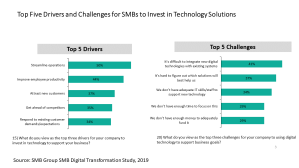Does your business have the technology foundation necessary to support growth in the digital economy?
If you’re like most SMB decision-makers, you know that business success increasingly relies on using technology solutions to meet shifting customer, market, and competitive requirements.  SMB Group research shows that 82% of SMBs agree that using new technology effectively is key to business growth—and a similar percentage agree that technology is reshaping their businesses and industries.
SMB Group research shows that 82% of SMBs agree that using new technology effectively is key to business growth—and a similar percentage agree that technology is reshaping their businesses and industries.
However, even though you see the writing on the wall, your business may be unprepared or underprepared to take action. In fact, our research also revealed that just 19% of SMBs say they have a well-defined digital business strategy, and just 24% are working on initiatives to prepare their businesses for a digital future.
Integration Issues Hamper Innovation
Using technology to work smarter, not harder is critical to streamline operations, improve productivity, attract new customers, and stay ahead of changing trends.
 However, it can be difficult to get the value your business needs from technology. Many SMBs lack the time, expertise, and money they need to figure out what solutions they need and chart a path that will provide them with the outcomes they desire.
However, it can be difficult to get the value your business needs from technology. Many SMBs lack the time, expertise, and money they need to figure out what solutions they need and chart a path that will provide them with the outcomes they desire.
Even more often, SMBs struggle with “difficulty integrating new digital technologies with existing systems.” This isn’t surprising when you consider that 80% currently rely on manual data entry, batch file uploads, and/or custom code to meet all or part of their integration needs.[1]
If your business is using disjointed solutions that don’t work together, it’s likely that people are spending too much time manually integrating and reconciling information. This leaves less time to focus on customers and the innovation that’s needed to move the business ahead. Information can easily slip through the cracks, making it all too easy to get blindsided by the unexpected. Trying to streamline workflows, make better decisions, or getting a pulse on customer trends can become Herculean tasks.
Intelligent ERP Can Help Solve the Integration and Innovation Problem
Most SMBs recognize the need to solve the integration problem: 43% of SMBs are currently investing to integrate their business applications, and another 33% plan to do so.[2] But integrating disconnected solutions “after the fact” is often difficult and expensive—and is unlikely to provide enough agility required to outflank the competition.
 This reality is driving more SMBs to consider pre-integrated, intelligent enterprise resource planning (ERP) solutions to remove integration friction, streamline workflows, and get real-time insights required to respond quickly to customer, supply chain, and operational trends.
This reality is driving more SMBs to consider pre-integrated, intelligent enterprise resource planning (ERP) solutions to remove integration friction, streamline workflows, and get real-time insights required to respond quickly to customer, supply chain, and operational trends.
Modern, intelligent ERP solutions are built on unified, extensible platforms. They automate business processes across core areas such as financials, order fulfillment, payments, inventory, supply chain, human resources, marketing, sales, service, and more.
Applications within an ERP suite are integrated with each other, so business-critical information is updated in real-time across related business processes, such as order to cash. This reduces the need for redundant data entry, speeds up repetitive processes, and ensures everyone has the same information to use for decision-making. ERP suites also offer a consistent user interface across applications, making it easier for employees who work in different parts of the business, or for those who need to retrain for a new role.
Although ERP solutions offer a lot of functionality, most allow for a phased approach. You can start by automating key areas, such as financials, payments, and supply chain, and add additional capabilities as you need them in an incremental, yet integrated way.
ERP vendors are also building artificial intelligence and machine learning (AI and ML) into their platforms to turbocharge the automation and intelligence that these solutions provide. As a result, you can reap the benefits of these technologies from within the ERP solution—without having to become an AI and ML expert.
Some of the top advantages that an intelligent ERP suite offers include:
- Streamlined business processes with workflow automation. Intelligent, integrated ERP systems are designed to connect the dots between people and processes within and across different business functions. Information flows freely, in real-time to the people that need it to get their jobs done. This slashes the need for repetitive, manual data input and reconciliation tasks; decreases the odds of human error; and speeds up processes. Intelligent ERP systems also provide users with proactive alerts and notifications to help identify potentially risky situations. For example, they can detect when stocks need to be replenished, and automatically trigger reorders.
- Better decision making with real-time, comprehensive information. No more dueling spreadsheets or “seat of the pants” decision-making. You enter data just once into the ERP system, and it’s updated in real-time across different modules. Users get consistent, accurate information—which improves collaboration and speeds up decision-making. Getting a more holistic view of information can, for instance: help you close the books more quickly; identify and remedy customer service problems before they spiral, and determine the qualities that drive employee performance in a given role.
- Next-generation automation through robotic process automation (RPA). RPA uses AI to automate routine and repetitive tasks and processes with bots programmed to replicate how humans would carry out tasks, such as entering information in spreadsheets or transferring data among multiple systems. ERP with RPA capabilities could, for example, help you to automatically determine product attributes by reading and interpreting description text, or predict supply delivery delays and suggest steps to take to minimize production impact.
Flexibility for the Future
An open, extensible cloud-based platform approach empowers intelligent ERP vendors—and their partners—to easily add new functionality to their offerings. Vendors can expose platform features and functions via microservices and an abstraction layer. Using “low code” drag and drop visual development tools, developers can quickly build add-on applications directly on the platform while a Cloud-based ERP offers extensive flexibility for the future.
This means that third-party partners and customer developers can take advantage of security, scalability, and other functionality built into the ERP platform. Developers don’t have to reinvent the wheel—and customers automatically reap platform benefits in these third-party apps. As ERP vendors embed additional technologies, such as AI, ML, Internet of Things (IoT), and blockchain into their platforms, they can pass these capabilities through to developers as well—enabling a steady stream of innovative new applications.
Perspective
It’s easy to become complacent. After all, change is hard.
But as the Greek philosopher Heraclitus noted, “The only constant in life is change.” And, as the rate of change in technology and business accelerates, the ability to detect, manage, and stay ahead of change is increasingly linked to business survival and growth.
In fact, the cost of sticking with outdated, disconnected business solutions may be one most SMBs can’t afford.
Intelligent ERP can put your business on solid footing to work smarter—and to adjust, improve, and capitalize on the inevitable changes that lie ahead. It’s time to critically examine how well current technology strategy and solutions serve the business today—and assess whether they’ll be able to provide the agility your business needs to thrive in the future.
For more expert advice on Intelligent ERP, read SAP’s executive guide, Adapt, Grow & Thrive with Intelligent ERP.
[1] SMB Group SMB 360: Connecting the Dots Between Business and Technology Study, 2019
[2] SMB Group SMB Digital Transformation Study, 2019
This post was sponsored by SAP.
© SMB Group
Source: Laurie McCabe’s Blog

